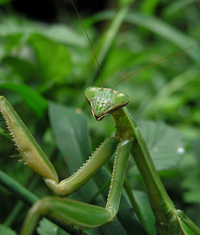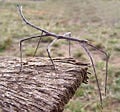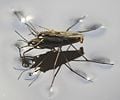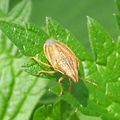Insect
| Insects | ||||||||
|---|---|---|---|---|---|---|---|---|
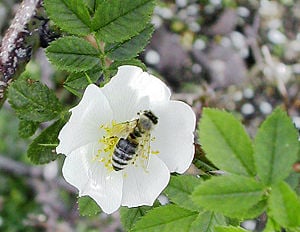 Honeybee (order Hymenoptera) | ||||||||
| Scientific classification | ||||||||
| ||||||||
| Classes & Orders | ||||||||
Insects are invertebrate animals of the Class Insecta, the largest and (on land) most widely distributed taxon (taxonomic unit) within the Phylum Arthropoda. Insects comprise the most numerous and diverse group of animals, with around 925,000 species described. Indeed, insects represent more than half (about 57 percent) of all identified animal species, and some authorities estimate that less than 10 percent of living insect species actually have been described and named. Pliny the Elder noted: "In no one of her works has Nature more fully displayed her exhaustless ingenuity."
Insects occupy a critical role in both ecology and human society. Being widespread and numerous, they are a vital link in food webs. They are also invaluable as pollinators and in the recycling of nutrients. With respect to humans, insects are both economically helpful (producing silk, honey, shellac, and pollinating agricultural crops) and have devastating consequences as agricultural pests and bearers of disease. Historically, insects have been very important as symbols in religions, whether in myths related to the creation of the world or the scarab serving as the most important religious symbol of ancient Egypt. Ahimsa, a core belief of Hinduism, Jainism, and Buddhism, is the principle of refraining from causing pain to any living creature. Some practitioners make great efforts to avoid even accidental injury to insects, such as wearing gauze masks, avoiding or limiting eating during seasons when insects are abundant, and straining water before drinking.
Crop damage and insect-borne diseases, such as malaria, have led to many efforts to control insects. However, it is important that control measures be carefully evaluated, as many can backfire, destroying helpful insects as well, and impacting animals that consume insects.
The study of insects is called entomology.
Characteristics and diversity
As arthropods, insects have jointed appendages (arthropod means "jointed foot"), an exoskeleton (hard, external covering), segmented body, ventral nervous system, digestive system, open circulatory system, and specialized sensory receptors. The term "jointed appendages" refers to both legs and antennae.
Insects are distinguished from other arthropods by having three pairs of jointed legs; an abdomen that is divided into 11 segments and lacks any legs or wings; and a body separated into three parts (head, thorax, and abdomen), with one pair of antennae on the head. Often, insects have one or two pairs of wings as well.
The true insects (that is, species classified in the Class Insecta) are also distinguished from all other arthropods in part by having ectognathous, or exposed, mouthparts. This is the reason they are sometimes termed Ectognatha, which is synonymous with Insecta. Most species, but by no means all, have wings as adults. Terrestrial arthropods, such as centipedes, millipedes, scorpions, and spiders, are sometimes confused with insects due to the fact that both have similar body plans, sharing (as do all arthropods) a jointed exoskeleton.
Insects are found in nearly all environments on the planet, although only a small number of species have adapted to life in the open ocean, where crustaceans tend to predominate. Insects have an ability to adapt to extreme temperatures, and are even found on glaciers on the world's highest mountains, in the South Pole, and in hot springs.
Insects range in size from less than a millimeter to over 18 centimeters (some walkingsticks) in length.
The beetles are the most numerous insects, with over 400,000 species identified. There also are approximately 170,000 butterfly and moth, 120,000 fly, 82,000 true bug (Hemiptera), 110,000 bee and ant, 5,000 dragonfly, 2,000 praying mantis, and 20,000 grasshopper species. However, thousands of new insect species are identified each year, and estimates of the total number of current species, including those not yet known to science, range from two to thirty million, with most authorities favoring a figure midway between these extremes.
Morphology and development
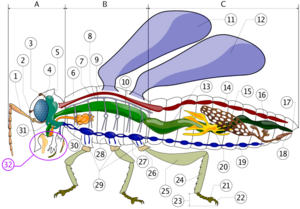
A- Head B- Thorax C- Abdomen
1. antenna
2. ocelli (lower)
3. ocelli (upper)
4. compound eye
5. brain (cerebral ganglia)
6. prothorax
7. dorsal artery
8. tracheal tubes (trunk with spiracle)
9. mesothorax
10. metathorax
11. first wing
12. second wing
13. mid-gut (stomach)
14. heart
15. ovary
16. hind-gut (intestine, rectum & anus)
17. anus
18. vagina
19. nerve chord (abdominal ganglia)
20. Malpighian tubes
21. pillow
22. claws
23. tarsus
24. tibia
25. femur
26. trochanter
27. fore-gut (crop, gizzard)
28. thoracic ganglion
29. coxa
30. salivary gland
31. subesophageal ganglion
32. mouthparts
Insects possess segmented bodies supported by an exoskeleton, a hard outer covering made mostly of chitin. The body is divided into a head, a thorax, and an abdomen. The head supports a pair of sensory antennae, a pair of compound eyes, and a mouth. The thorax has six legs (one pair per segment) and wings (if present in the species). The abdomen has excretory and reproductive structures.
The insect nervous system can be divided into a brain and a ventral nerve cord. As the head capsule is made up of six anterior body segments, the brain reflects this in its anatomy in containing six pairs of ganglia. The first three pairs are fused into the brain, while the three following pairs are fused into a structure called the subesophageal ganglion. The thorax pairs have one ganglion on each side, with one pair of ganglia in each thoracic segment. This arrangement is also found in the abdomen, but there is one pair of ganglia in the first eight segments only. That is, there are three thoracic and eight abdominal paired ganglia.
While this description represents an "idealized" insect, in reality many species of insects have a lower number of ganglia. This is attributed to an evolutionary loss of ganglia or the fusing of some of the abdominal ganglions and/or fusing of those in the thorax. For example, some cockroachs have just six ganglia in the abdomen, whereas the wasp Vespa crabro has reduced the number further with only two in the thorax and three in the abdomen. Some insects, like the well-known housefly, have fused all the body ganglions into one big thoracic ganglion.
Insects have a complete digestive system. That is, their digestive system consists basically of a tube that runs from mouth to anus, contrasting with the incomplete digestive systems found in many simpler invertebrates. The excretory system consists of Malpighian tubules for the removal of nitrogenous wastes and the hindgut for osmoregulation. At the end of the hindgut, insects are able to reabsorb water along with potassium and sodium ions. Therefore, insects do not usually excrete water with their feces, aiding storage of water in the body. This process of re-absorption enables them to withstand hot, dry environments.
Most insects have two pairs of wings located on the second and third thoracic segments. Insects are the only invertebrate group to have developed flight, and this has played an important part in their success. The winged insects, and their wingless relatives, make up the subclass Pterygota. Insect flight is not very well understood, relying heavily on turbulent atmospheric effects. In more primitive flying insects, flight tends to rely on direct flight muscles, which act upon the wing structure. More advanced flyers, which make up the Neoptera, in general, have wings that can be folded over their back, keeping them out of the way when not in use. In these insects, the wings are powered mainly by indirect flight muscles that move the wings by stressing the thorax wall. These muscles are able to contract when stretched without nervous impulses, allowing the wings to beat much faster than would be otherwise possible.
Insects’ outer skeleton, called the cuticle, is made up of two layers: the epicuticle, which is a thin and waxy, water-resistant, outer layer and contains no chitin, and another layer under it called the procuticle. The procuticle is chitinous and much thicker than the epicuticle, and it can be divided into two new layers. The first one is named the exocuticle and the second and deepest one is the endocuticle. The very tough and flexible endocuticle is built of numerous layers, made of fibers of chitin and proteins crossing each others in a sandwich pattern.
Insects use tracheal respiration in order to transport oxygen through their bodies. Openings on the surface of the body called spiracles lead to the tubular tracheal system. Air reaches internal tissues via this system of branching trachea. There are never more than one pair of spiracles per segment, and never more than two pairs of spiracles on the thorax (mesothorax and metathorax), or more than eight pairs on the abdomen (the first eight segments). Many higher insects have reduced the number of spiracles; the hoverflies have lost all the spiracles on their abdomen. There is a limit to the pressure that the walls of the tracheal tubes can withstand without collapsing, even if they are stiffened with bands of chitin, which is one of the reasons why insects are relatively small.
The spiracles are equipped with muscle-controlled valves, enabling the insects to open and close them. By closing them, they can avoid drowning in water, as well as prevent moisture from escaping their body by opening them only when new air is needed. When there is little activity, the spiracles are often partially closed. To stop dust and other unwelcome small particles from entering their trachea system when inhaling, the spiracles have hair that filters the particles away.
There are some species of insects, like members of Chironomidae, commonly called "blood worms," that contain true respiratory pigments such as hemoglobin during their larval stage. Here the tracheae are often reduced as their body can absorb oxygen directly from the water, allowing them to live in the bottom mud where oxygen levels are low. Three pairs of the spiracles in water bugs are covered by a pressure-sensitive membrane. These work in much the same way as the human inner ear, and make it possible to sense their position in the water.
The last abdominal spiracle and associated trachea of caterpillars in the Lepidoptera area also are different. The trachea of the eighth segment is modified into what can be called a trachea lung, which is adapted to hemocyte gas exchange. Short tracheoles from this trachea end in knots within the tracheole cell basement membrane. Since they do not supply any cellular tissue, it seems most likely that they are supplying the hemocytes with oxygen. The Madagascar hissing cockroach expels air from certain spiracles to create a loud hissing sound.
A diffuse tissue of cells found throughout the hemocoel of insects, most of all in the abdomen, is called the fat body. Energy storage and metabolic processes are among its main functions. It is also the closest that insects have to an organ functioning like a liver.
The circulatory system of insects, like that of other arthropods, is open: The heart pumps the hemolymph through arteries to open spaces surrounding the internal organs. When the heart relaxes, the hemolymph seeps back into the heart.
Like some other invertebrates, insects cannot synthesize cholesterol and must receive it from their diet. With a very few exceptions, they also depend on long-chain fatty acids in their diet, especially 18-carbon chains. A lack of these fatty acids will affect their development in a negative way, resulting in such impacts as longer time to mature and deformed adults.
Some insects also have polyembryony. A single fertilized egg from polyembryonic parasitic wasps can actually divide into literally thousands of separate embryos.
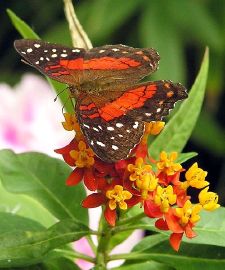
Most insects hatch from eggs, others are ovoviviparous or viviparous, and all undergo a series of molts as they develop and grow in size. This manner of growth is necessitated by the exoskeleton. Molting is a process by which the individual escapes the confines of the exoskeleton in order to increase in size, then grows a new outer covering.
In many types of insects, the young, called nymphs, are basically similar in form to the adults (such as grasshoppers and termites), though wings are not developed until the adult stage, and reproductive organs are undeveloped. This is called incomplete metamorphosis, and involves the stages of egg, nymph, and adult.
Complete metamorphosis distinguishes the Endopterygota, which includes many of the most successful insect groups. In these species, an egg hatches to produce a larva, which is generally worm-like in form, including eruciform (caterpillar-like), scarabaeiform (grublike), campodeiform (elongated, flattened, and active), elateriform (wireworm-like), and vermiform (maggot-like). The larva grows and eventually becomes a pupa, a stage sealed within a cocoon (or chrysalis) in some species. There are three types of pupae: obtect, exarate, and coarctate. In the pupal stage, the insect undergoes considerable change in form to emerge as an adult (or imago). Butterflies are an example of an insect that undergoes complete metamorphosis. Metamorphosis aids survival in that there is no competition for resources between the adult and the larva, and helps in survival, since often the pupal stage occurs during harsh conditions, such as winter.
Other development traits found in various insects are haplodiploidy, polymorphism, paedomorphosis, sexual dimorphism, parthenogenesis, and more rarely hermaphroditism.
Behavior
Many insects possess very refined organs of perception. In some cases, particular senses can be more capable than humans. For example, bees can see in the ultraviolet spectrum, and male moths have a specialized sense of smell that enables them to detect the pheromones of female moths over distances of many kilometers.
Many insects also have a well-developed number instinct, especially among the solitary wasps. The mother wasp lays her eggs in individual cells and provides each egg with a number of live caterpillars on which the young feed when hatched. Some species of wasp always provide five, others 12, and others as high as 24 caterpillars per cell. The number of caterpillars is different among species, but it is always the same for each sex of the eggs. The male solitary wasp in the genus Eumenus is smaller than the female, so the mother supplies him with only five caterpillars; the larger female receives ten caterpillars in her cell. In other words, she can distinguish between both the numbers five and ten in the caterpillars she is providing and which cell contains a male and which contains a female.
There are a number of other examples of parental behavior in insects. Males of the giant water bug (family Belastomatidae) carry the eggs on their backs until they hatch. The leaf beetle (Gonioctena sibirica) remains with the larvae until their last larval molt. A number of species protect the eggs and nymphs from predators, and several species also provide food.
Some insect species are considered social insects, such as the ant, the bee, and the termite. They live together in large, well-organized colonies that are so tightly integrated and genetically similar that the colonies are sometimes considered superorganisms. These complex societies have specialization or division of labor, with various individuals providing different functions, such as protection, gathering food, and reproduction.
Communication is an important behavior in insects. Of course, in social insects, communication plays a critical role in coordinating among the organisms. For example, bees communicate via a "dance," that can direct other bees to a food source. But even solitary insects communicate at various times, such as to attract mates. One means of communication is via pheromones, a chemical that affects the behavior of other insects. For example, ants follow a train of pheromones when they are marching, and the pheromone of the queen bee prevents other queens from being raised up in the same hive. Some insects communicate via sound, such as the chirps of male crickets to attract females and warn male crickets away from their territories. The flashes of fireflies represent another communication method for finding a mate, allowing the males and females to find a mate of the same species.
Taxonomy
According to one common taxonomic scheme, presented below, the millions of insect species in the class Insecta are divided into two subclasses; Apterygota (wingless insects) and Pterygota (flying insects, including those that are secondarily wingless). These are further divided into over 40 orders, about 30 of which have living representatives.
Subclass: Apterygota
- Orders
- Archaeognatha (Bristletails)
- Thysanura (Silverfish)
- Monura - extinct
Subclass: Pterygota
- Infraclass: "Paleoptera" (paraphyletic)
- Orders
- Ephemeroptera (mayflies)
- Palaeodictyoptera - extinct
- Megasecoptera - extinct
- Archodonata - extinct
- Diaphanopterodea - extinct
- Protodonata - extinct
- Odonata (dragonflies and damselflies)
- Infraclass: Neoptera
- Superorder: Exopterygota
- Orders
- Caloneurodea - extinct
- Titanoptera - extinct
- Protorthoptera - extinct
- Polyneoptera
- Grylloblattodea (ice-crawlers)
- Mantophasmatodea (gladiators)
- Plecoptera (stoneflies)
- Embioptera (webspinners)
- Zoraptera (angel insects)
- Dermaptera (earwigs)
- Orthopteroidea
- Orthoptera (grasshoppers, etc)
- Phasmatodea (walking sticks)
- Dictyoptera
- Paraneoptera
- Superorder: Endopterygota
- Orders
- Hymenoptera (ants, bees, etc.)
- Coleoptera (beetles)
- Strepsiptera (twisted-winged parasites)
- Neuropteroidea
- Raphidioptera (snakeflies)
- Megaloptera (alderflies, etc.)
- Neuroptera (net-veined insects)
- Mecopteroidea
- Amphiesmenoptera
- Incertae sedis
- Glosselytrodea - extinct
- Miomoptera - extinct
Apterygota is made up of two orders with living representatives: Archaeognatha (bristletails) and Thysanura (silverfish). In some recommended classifications, the Archaeognatha makes up the Monocondylia, while Thysanura and Pterygota are grouped together as Dicondylia.
The Neoptera infraclass (which in some taxonomies is a superorder) includes insects that can fly and that can flex their wings over their abdomens. In the classification presented above, Neoptera is divided into the superorders Exopterygota and Endopterygota. The Endopterygota (also called Holometabola) include those insects whose wings develop inside the body, and that undergo a complete metamorphosis (different larval, pupal, and adult stages). The Exopterygota (also called Hemipterodea) include insects whose wings develop outside the body, and lack a pupal stage. The Exopterygota part of the Neoptera are sometimes divided into Orthopteroida (cerci present) and Hemipteroida (cerci absent), also called lower and higher Exopterygota.
A few smaller groups with similar body plans, such as springtails (Collembola), are united with the insects in the subphylum Hexapoda. But this subphylum appears to be artificial and springtails are no longer considered as relatives, but are considered to have a different origin.
Roles in the environment and human society
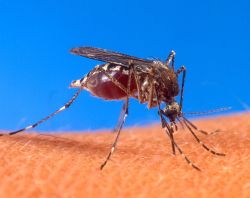
Many insects are considered pests by humans. Insects commonly regarded as pests include those that are parasitic (mosquitoes, lice, bedbugs), transmit diseases (mosquitoes, flies), damage structures (termites), or destroy agricultural goods (locusts, weevils). Many entomologists are involved in various forms of pest control, often using insecticides, but more and more relying on methods of biological control.
Although pest insects attract a great deal of attention, many insects are beneficial to the environment and to humans. Some pollinate flowering plants (for example, wasps, bees, butterflies, and ants). Pollination is a trade between plants that need to reproduce, and pollinators that receive rewards of nectar and pollen. A serious environmental problem today is the decline of populations of pollinator insects, and a number of species of insects are now cultured primarily for pollination management in order to have sufficient pollinators in the field, orchard, or greenhouse at bloom time.
Insects also produce useful substances such as honey, wax, lacquer, and silk. Honeybees have been cultured by humans for thousands of years for honey, although contracting to provide honeybees for crop pollination is becoming more significant for beekeepers. The silkworm has greatly affected human history, as silk-driven trade established relationships between China and the rest of the world. In addition, fly larvae (maggots) were formerly used to treat wounds to prevent or stop gangrene, as they only consume dead flesh. This treatment is finding modern usage in some hospitals. Insect larvae of various kinds are also commonly used as fishing bait.
In some parts of the world, insects are used for human food ("entomophagy"), while being a taboo in other places. There are proponents of developing this use to provide a major source of protein in human nutrition. Since it is impossible to entirely eliminate pest insects from the human food chain, insects already are present in many foods, especially grains. Most people do not realize that food laws in many countries do not prohibit insect parts in food, but rather limit the quantity. According to cultural materialist anthropologist Marvin Harris, the eating of insects is taboo in cultures that have protein sources that require less work, like farm birds or cattle.
Many insects, especially beetles, are scavengers, feeding on dead animals and fallen trees, recycling the biological materials into forms found useful by other organisms.
Insects are an integral part of the food web, whether consumer, prey, or predator. Although largely unnoticed by most humans, one of the most useful of all insects are insectivores, those that feed on other insects. Many insects, such as grasshoppers, can potentially reproduce so quickly that they could literally bury the earth in a single season. However, there are hundreds of other insect species that feed on grasshopper eggs, and some that feed on grasshopper adults. This role in ecology is usually assumed to be primarily one of birds, but insects, though less glamorous, are much more significant. For any pest insect one can name, there is a species of wasp that is either a parasitoid or predator upon that pest, and plays a significant role in controlling it.
Human attempts to control pests by insecticides can backfire, because important but unrecognized insects already helping to control pest populations are also killed by the poison, leading eventually to population explosions of the pest species.
Insects have also occupied an important historical role in culture and religion. The ancient Egyptian religion made the beetle their most important religious symbol and represented them as scarabeums. Shamanistic societies had a number of myths that placed beetles as the creators of the world, and in some South American Indian tribes, it was a large beetle named Aksak that took clay and made men and women. The Bible has 120 or more references to insects. In some cases, they symbolize evil and destruction, such as plagues of locusts or flies. The principle of ahimsa—practiced in Jainism, Hinduism, and Buddhism— presents the view of all life being sacred, even that of insects, and strict practitioners take all kinds of precautions not to injure insects, including sweeping the path on which they are walking.
History of insects

The relationships of insects to other animal groups remain unclear. Although traditionally grouped with millipedes and centipedes, there is growing support for the view that insects have closer evolutionary ties with the crustaceans. In the Pancrustacea theory, insects, together with Remipedia and Malacostraca, make up a natural clade.
Apart from some tantalizing Devonian fragments, insects first appear suddenly in the fossil record at the very beginning of the Late Carboniferous period, Early Bashkirian age, about 350 million years ago. Insect species were already diverse and highly specialized by this time, with fossil evidence reflecting the presence of more than half a dozen different orders. Their diversity and prominence has led to speculation that the first insects probably emerged earlier in the Carboniferous period, or even in the preceding Devonian. Research to discover these earliest insect ancestors in the fossil record continues.
The origin of insect flight remains obscure, since the earliest winged insects currently known appear to have been capable fliers. Some extinct insects had an additional pair of winglets attaching to the first segment of the thorax, for a total of three pairs. So far, there is nothing that suggests that the insects were a particularly successful group of animals before they got their wings.
Late Carboniferous and Early Permian insect orders include both several current, very long-lived groups and a number of Paleozoic forms. During this era, some giant dragonfly-like forms reached wingspans of 55 to 70 cm, making them far larger than any living insect. Also, their nymphs must have had a very impressive size. This gigantism may have been due to higher atmospheric oxygen levels that allowed increased respiratory efficiency relative to today. The lack of flying vertebrates could have been another factor.
Most extant orders of insects developed during the Permian era that began around 270 million years ago. Many of the early groups became extinct during the Permian-Triassic extinction event, the largest mass extinction in the history of the Earth, around 252 million years ago.
The remarkably successful Hymenopterans appeared in the Cretaceous but achieved their diversity more recently, in the Cenozoic. A number of highly successful insect groups evolved in conjunction with flowering plants, a powerful illustration of co-evolution.
Many modern insect genera developed during the Cenozoic; insects from this period on are often found preserved in amber, often in perfect condition. Such specimens are easily compared with modern species. The study of fossilized insects is called paleoentomology.
ReferencesISBN links support NWE through referral fees
- Grimaldi, D., and M. S. Engel. 2005. Evolution of the Insects. Cambridge, UK: Cambridge University Press. ISBN 978-0521821490
- Johnson, N. F., and C. A. Triplehorn. 2004. Borror and DeLong's Introduction to the Study of Insects, 7th Edition. Cengage Learning. ISBN 978-0030968358
- McCubbin, K. I., and J. M. Weiner. 2002. Fire ants in Australia: a new medical and ecological hazard. Medical Journal of Australia 176(11):518–519.
- Towle, A. 1989. Modern Biology. Austin, TX: Holt, Rinehart and Winston. ISBN 978-0030139192
Gallery
Common Earwig (Forficula auricularia)
Aleiodes indiscretus parasitising a gypsy moth (Lymantria dispar) larva
Credits
New World Encyclopedia writers and editors rewrote and completed the Wikipedia article in accordance with New World Encyclopedia standards. This article abides by terms of the Creative Commons CC-by-sa 3.0 License (CC-by-sa), which may be used and disseminated with proper attribution. Credit is due under the terms of this license that can reference both the New World Encyclopedia contributors and the selfless volunteer contributors of the Wikimedia Foundation. To cite this article click here for a list of acceptable citing formats.The history of earlier contributions by wikipedians is accessible to researchers here:
The history of this article since it was imported to New World Encyclopedia:
Note: Some restrictions may apply to use of individual images which are separately licensed.
